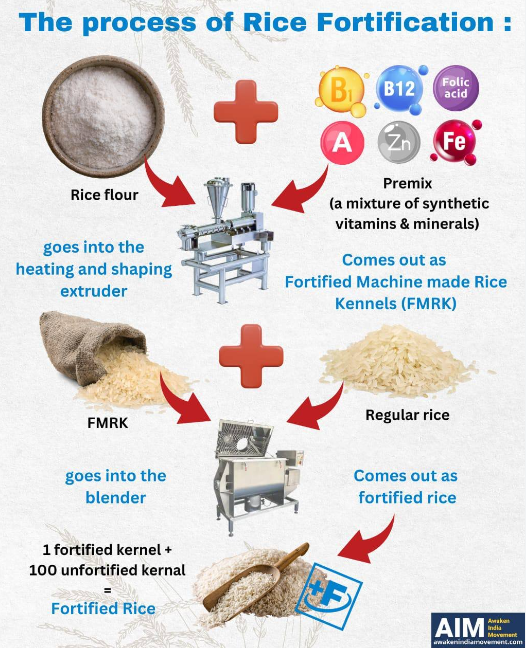18 October 2024 : PIB Summary For UPSC
1. Fortified Rice: Centre’s ambitious initiative to combat micronutrient deficiencies
(Source – https://pib.gov.in/PressReleseDetail.aspx?PRID=2065835®=3&lang=1 )
| Context |
|

Government Policy Regarding Fortified Rice
- The Union Cabinet approved the continuation of the fortified rice initiative under various welfare schemes from July 2024 to December 2028.
- A total of 520 Lakh Metric Tons (LMT) of fortified rice is to be procured annually under the Pradhan Mantri Garib Kalyan Anna Yojana (PMGKAY).
- Over 21,000 of the 30,000 operational rice mills have installed blending equipment, with a production capacity of 223 LMT of fortified rice monthly.
- Scientific assessments indicate that fortified rice is safe for all individuals, including those with hemoglobinopathies like Thalassemia and Sickle Cell Anaemia, leading to the removal of unnecessary advisory labels on packaging.
| What is Fortified Food? |
|
How Fortified Rice Can Solve Issues in India
- Rice fortification is essential in India, where 65% of the population consumes rice daily, addressing micronutrient deficiencies, particularly iron.
- Fortified rice can help reduce anaemia rates, especially among vulnerable groups such as women and children.
- The initiative aligns with global practices, improving overall public health outcomes by providing a simple and effective means of enhancing diet quality.
| Practice Question: Discuss the significance of iron-fortified rice in addressing micronutrient deficiencies in India. Evaluate the government’s policy initiatives regarding rice fortification and its possible advantages. (150 Words /10 marks) |
2. Government will take all measures for the preservation and development of the Pali language
(Source –https://pib.gov.in/PressReleseDetail.aspx?PRID=2065892®=3&lang=1 )
| Context |
|

Pali Language
- Origin: Pali is an ancient Indo-Aryan language, derived from Sanskrit, primarily associated with Theravada Buddhism.
- Script: Pali is commonly written in the Brahmi script, as well as other scripts like Roman and Sinhala.
Buddhist Literature in Pali
- Tipitaka (Three Baskets): The foundational scripture of Theravada Buddhism, comprising:
- Vinaya Pitaka: Rules for monastic discipline.
- Sutta Pitaka: Discourses attributed to the Buddha and his disciples.
- Abhidhamma Pitaka: Philosophical and doctrinal analysis.
- Suttas: Key texts include the Dhammapada, a collection of verses on ethical conduct and wisdom.
- Jataka Tales: Stories of the Buddha’s previous lives, emphasising moral lessons.
- Commentaries: Important commentaries like the Visuddhimagga (Path of Purification) provide interpretations of texts and teachings.
- Influence: Pali literature has significantly shaped Buddhist thought, philosophy, and practice across Asia.
| Practice Question: Discuss the significance of the Pali language in preserving Buddhist literature and its impact on the spread of Theravada Buddhism. (150 Words /10 marks) |

